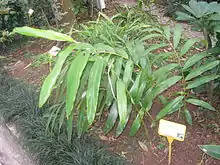Amomum villosum
Wurfbainia villosa, also known by its basonym Amomum villosum,[2] (Chinese : 砂仁) is a plant in the ginger family that is grown throughout Southeast Asia and in South China.[3] Similar to cardamom, the plant is cultivated for its fruits, which dry into pods when mature and contain strongly aromatic seeds.[4] W. villosa is an evergreen plant in the ginger family, grow in the shade of the tree, 1.5 to 3.0 m high, whose branches and leaves are similar to ginger's. W. villosa has a characteristic that flowers spread on the ground can bear fruit while flowers on the branches can not. Its flowers bloom in March and April and are the colour of white jade.
| Amomum villosum | |
|---|---|
 | |
| W villosa at the Hong Kong Botanical Garden | |
| Scientific classification | |
| Kingdom: | Plantae |
| Clade: | Tracheophytes |
| Clade: | Angiosperms |
| Clade: | Monocots |
| Clade: | Commelinids |
| Order: | Zingiberales |
| Family: | Zingiberaceae |
| Genus: | Wurfbainia |
| Species: | W. villosa |
| Binomial name | |
| Wurfbainia villosa (Lour.) Skornick. & A.D.Poulsen | |
| Synonyms | |
| |
Uses
The pods are used in Chinese herbology to treat stomachache and dysentery and in Chinese cuisine for flavour.[4]
Herbology
W. villosa has the tastes of sweet, sour, bitter, salty, and spicy; its flowers, fruit, roots, stems and leaves can be used as medicine. Since the Tang dynasty, many ancient books of medicine records such as the Compendium of Materia Medica and some other books say W. villosa tastes acrid but fresh, slightly bitter.
Cuisine
W. villosa is a good condiment. A grain of W. villosa in a dish being steamed can fill the house with its fragrance.
Conservation
Due to the demand for seeds and ripe fruits, and to curb slash-and-burn activities in forests by local populations, cultivation of W. villosa and coplantings with rubber trees has been encouraged by the governments of Yunnan and Guangdong, China.[5] However, the extensive cultivation of W. villosa in forests has resulted in the reduction of species diversity in the rainforests of Southwest China.[6]
References
- IUCN 2012. IUCN Red List of Threatened Species. Version 2012.2. <www.iucnredlist.org>. Downloaded on 23 November 2012.
- POWO: Wurfbainia villosa (Lour.) Skornick. & A.D.Poulsen (retrieved 15 July 2020)
- "Amomum villosum", Encyclopedia of Life
- G. Li; A.J. Chen; X.Y. Chen; X.L. Li & W.W. Gao (2010), "First report of Amomum villosum (cardamom) leaf lesion caused by Pyricularia costina in China", New Disease Reports, 22 (2): 2, doi:10.5197/j.2044-0588.2010.022.002
- Zhou, Shouqing (1993), "Cultivation of Amomum villosum in tropical forests", Forest Ecology and Management, 60 (1–2): 157–162, doi:10.1016/0378-1127(93)90029-M
- Liu, Hongmao; Gao, Lei; Zheng, Zheng; Feng, Zhili (2006), "The impact of Amomum villosum cultivation on seasonal rainforest in Xishuangbanna, Southwest China", Biodiversity and Conservation, 15 (9): 2971–2985, doi:10.1007/s10531-005-3876-4, S2CID 10958050
